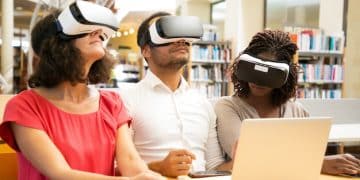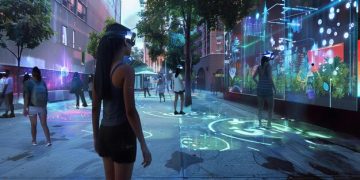Augmented reality applications in education and training

Augmented reality applications in education and training enhance learning experiences by making lessons interactive, engaging students and improving knowledge retention through immersive and personalized content.
Augmented reality applications in education and training are changing the way we learn and teach. Imagine immersing students in a 3D environment where they can explore concepts hands-on. Curious about how this technology can enhance learning? Let’s dive in.
how augmented reality transforms classroom learning
Augmented reality (AR) is changing how we approach classroom learning. Teachers and students can now explore lessons in ways that were not possible before. By using AR, lessons become interactive and engaging, allowing students to visualize concepts strongly.
Benefits of Using Augmented Reality in the Classroom
Incorporating AR into lessons has numerous benefits. First, it enhances student engagement significantly. Learners are more likely to participate when they can see and touch digital elements in their learning environment. Second, it promotes better understanding of complex subjects.
- Improved visual learning experience
- Increased student retention
- Hands-on practice in a safe environment
Moreover, AR can help in accommodating diverse learning styles. Some students benefit from visual aids, while others may thrive in interactive experiences. This flexibility makes AR an excellent tool for teachers aiming to reach every student.
Real-World Applications of Augmented Reality
Many schools are already utilizing AR for various subjects. For example, in science classes, students can dissect virtual frogs, which makes the experience both safe and educational. History classes can come alive as students explore ancient civilizations through digital reconstructions.
Furthermore, languages can be learned more effectively with AR applications that interact with real-world objects. This method fosters a deeper connection to the subject matter. As AR technology continues to advance, we can expect even more innovative uses in education.
key benefits of augmented reality in training

Augmented reality (AR) brings many advantages to training environments. It creates immersive learning experiences that can enhance skills and knowledge retention. By making training more interactive, AR keeps participants engaged and motivated.
Enhanced Learning Experiences
AR provides a hands-on experience that traditional methods cannot match. Trainees can visualize processes, practice skills, and interact with digital elements in real-time. This approach leads to deeper understanding and better application of knowledge.
- Realistic simulations of real-world scenarios
- Immediate feedback on performance
- Opportunities for collaboration among trainees
Moreover, AR caters to different learning styles. Visual learners can benefit from seeing concepts in 3D, while kinesthetic learners engage more when they can touch and manipulate digital objects. This flexibility makes AR a valuable tool in various training settings.
Cost-Effective Training Solutions
Implementing AR in training can also save costs in the long run. Companies reduce the need for physical materials, travel expenses, and time away from work. By creating virtual training environments, organizations can train employees without the constraints of traditional methods.
As AR technology continues to evolve, we will see more companies adopting this innovative approach. The ability to create engaging and effective training programs is essential in today’s fast-paced work environments.
best practices for implementing augmented reality in education
Implementing augmented reality (AR) in education requires careful planning and execution. Schools can create engaging learning experiences when they follow certain best practices. Knowing how to integrate AR effectively can lead to improved student outcomes.
Planning and Curriculum Integration
First, it’s essential to align AR content with the curriculum. Teachers should identify which subjects can benefit most from AR. By selecting the right topics, educators can enhance the learning experience.
- Encourage collaboration among teachers for interdisciplinary projects.
- Use AR to supplement traditional teaching methods.
- Choose resources that align with learning objectives.
Furthermore, planning lessons around AR means considering both technology and pedagogy. This approach ensures that AR tools are integrated seamlessly into the classroom, promoting active learning.
Training for Educators
Teachers need proper training to utilize AR tools effectively. Providing professional development opportunities can help educators feel confident in using this technology:
- Offer workshops to familiarize teachers with AR applications.
- Encourage peer-to-peer learning among staff.
- Provide ongoing support and resources.
Investing in teacher training creates a skilled workforce ready to embrace AR. As teachers grow more comfortable with the technology, they can create more powerful learning experiences for students.
Feedback and Assessment
Finally, continuous feedback from students is crucial. This feedback can help educators adjust their approach and improve the AR experience. Pre- and post-assessments are effective methods for measuring student progress. By understanding what works, teachers can enhance their AR strategies.
Effective implementation of AR in education opens up new avenues for creativity and engagement. When educators take advantage of these best practices, they prepare students for a digital future.
future trends of augmented reality in learning environments

The future of augmented reality (AR) in learning environments looks promising. As technology evolves, it’s clear that AR will play a significant role in shaping how we educate students. With new tools and applications, learning will become even more immersive.
Integration with Artificial Intelligence
One exciting trend is the integration of AR with artificial intelligence (AI). This combination allows for personalized learning experiences. AI can analyze individual student performance and adjust AR content accordingly, making lessons more tailored to each learner’s needs.
- Dynamic content that adapts in real time.
- Enhanced feedback to students on their progress.
- Increased engagement through personalized challenges.
This approach not only keeps students engaged but also promotes mastery of subjects at their own pace.
Collaboration and Interaction
Another trend is the focus on collaboration through AR. Students can work together on projects in virtual spaces, regardless of their physical location. This method enhances teamwork skills and exposes learners to diverse perspectives.
As AR technology advances, we can expect:
- Real-time collaboration on shared AR experiences.
- Integration with cloud platforms for data sharing.
- Use of AR to connect classrooms around the world.
By fostering collaboration, AR can create a more connected and interactive learning experience for all students.
Expansion into Various Subjects
Lastly, the future will see AR expanding into more subjects beyond science and history. We are likely to witness innovative applications in art, music, and physical education. By making abstract concepts tangible, AR has the power to transform traditional teaching methods.
The potential for growth in AR is immense. As educators explore new possibilities, they will find creative ways to incorporate AR into their teachings. This continuous evolution is vital in preparing students for a fast-changing world.
FAQ – Frequently Asked Questions about Augmented Reality in Education
How will augmented reality change the way students learn?
Augmented reality will create immersive learning experiences, making lessons more engaging and interactive.
What are the benefits of integrating AR with artificial intelligence?
Combining AR with AI allows for personalized learning experiences tailored to each student’s needs, enhancing their understanding.
Can AR promote collaboration among students?
Yes, AR enables students to work together on projects in virtual environments, improving teamwork and communication skills.
What subjects can benefit from augmented reality?
AR can enhance the learning experience in various subjects, including science, history, art, and music, making complex concepts easier to understand.





